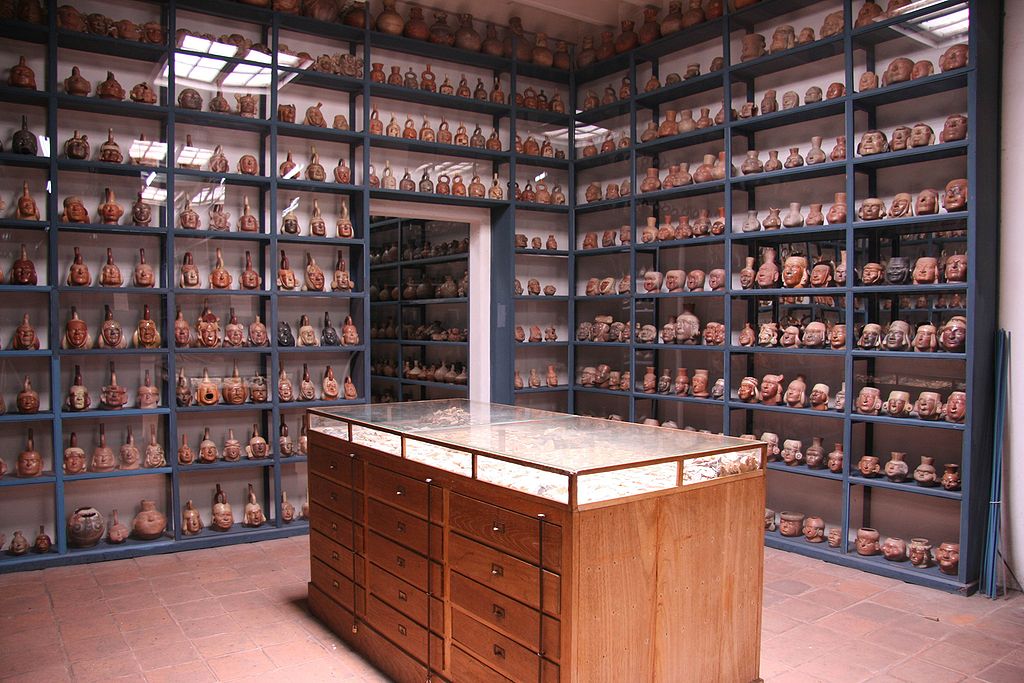A recent visit to Lima’s well-known museum of pre-Columbian art and artefacts, the privately-owned Museo Larco, reminded me of an old gripe: the fact that museums are like icebergs, the vast bulk of their collections are hidden.
After snaking through several dozen beautifully appointed rooms, each glittering with treasure, we were directed to another series of rooms on the opposite side of a pleasant courtyard. Unlike the neatly-ordered display cases in the main section of the museum, the shelves in these rooms were groaning under the weight of thousands of objects. Case after case of clay pots, vases, figures and drinking cups; all freely open to public view. No appointment necessary, no white gloves required – the open stores of the Museo Larco were a pleasant surprise.
My visit to the Larco stands in sharp contrast to my other experiences with museum stores. While undertaking an MA in Classics at King’s College London, we were taken, as a small group of students, to look at stored documents in the British Library. A white-gloved archivist unrolled a scroll – ancient Egyptian, if I remember correctly – but wouldn’t let us anywhere near it, as if the mere act of being in the same room with such an object was education enough.
During my PhD, I had better luck in Paris. In the French National Archives, I was able to call up boxes of letters, school records and other strange papers from the 1600s and 1700s to peruse at my leisure – no gloves required. Of course, unlike the Museo Larco, where all are welcome to view the museum’s stores, my ability to access 18th-century documents in Parisian archives was thanks to my academic pursuits. Nevertheless, despite what British museums would have us believe, restricting broader public access to collections for purposes of preservation isn’t orthodox everywhere.
The question of opening up museum stores is not new; neither is it without complication. Museums continue to face funding cuts, making it difficult to conceive of spending a great deal of additional money on the extra staffing, security and space required to open stored collections to the public. Nevertheless, a BBC Freedom of Information request revealed that in 2009 and 2010, the British Museum alone spent some £86,000 keeping an unbelievable 99% of its collection in storage, ‘preserving it for future generations’ as their press releases often state.
There’s a certain irony that in attempting to preserve their collections for future generations, many of London’s major museums prohibit the current generation from enjoying and experiencing the objects.
Significant financial donations have allowed the British Museum, at least, to begin to rectify the vast gap between collections in storage and those available for public viewing. They tell me that their soon-to-open World Conservation and Exhibitions Centre will ‘bring more of the study collection on site, and therefore more accessible to the public through the study rooms’. They also pointed out that visitors can make an appointment to request viewings of objects not on permanent display in the main building. The new Centre is a potentially promising step in the right direction, yet it remains unclear just how much more of currently stored collections will actually be made accessible to the public.
Even more promising is the new ceramics gallery at the Victoria and Albert Museum, where every piece from the ceramics collection is displayed in open stores. While, again, only 10% of the V&A’s collections are on display, there are other encouraging signs emanating from within. For example, the recently opened Clothworkers’ Centre provides open access to the V&A’s entire dress and textile collection. ‘In the future, though,’ says Kieran Long, Senior Curator of Contemporary Architecture, Design and Digital at the museum, ‘we aim to remove every barrier possible between the public and the collections…There’s a special intimacy that comes from encountering an object first hand. I personally believe we can trust the public more with things, and perhaps it might even be worth changing our policies on conservation to enable such access.’
Indeed, while the preservation of sensitive, historical objects for future generations or for academic study is certainly a worthy endeavour, we must make it our goal to open stored collections to the public. It’s perhaps a cliché, but too often curators and conservators remain fixated on the need to hide objects away for safekeeping. It’s difficult to argue with the figures, however. The balance between storage and display should be better than a ratio of 1–10% on show and 90–99% in closed stores. The point becomes more acute with regards to publicly funded institutions, for surely the responsibility to share knowledge is just as strong as the responsibility to conserve it.



